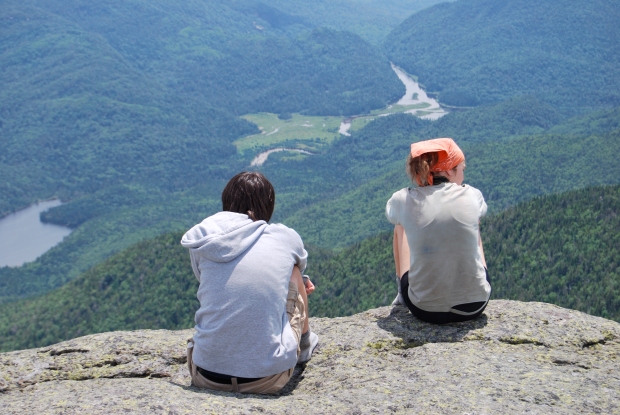The 46er Series: Algonquin
This hike made me question why I hiked at all. Algonquin, the second tallest peak in New York, at 5,114 ft., punched me in the gut, kicked me in the knees, and threw me down multiple times. But I still did it.
After Phelps, I was nervous and felt very unsteady in my hiking abilities. Hiking is a very popular activity, and I walked into it thinking that I would be able to do it without any issue. Then I realized I had asthma. Then, knee problems. Then, with those two problems combined, anxiety. I would think to myself, “There are eight year olds doing this, so I can do it too.” And I could do it, but I couldn’t do it because everyone else did. Personally, hiking is about me. And Algonquin taught me that.
We had to postpone our hike due to sore muscles from Phelps and thunderstorms. Instead of hiking on that day, we slept in front of the fireplace for four hours. The next day would be hiking day. We went to Lake Placid for dinner that night. You can see the MacIntyre range, which includes Algonquin, on the drive there. It was massive. We would be on top of that the next day.
In order to tackle the almost 9 miles to the summit, we started on the trail from the Adirondack Loj at Heart Lake nice and early that morning. Each of us grabbed a small stone to carry to the top, a tradition to preserve the fragile, alpine vegetation. The trail is beautifully maintained and keeps a steady uphill grade for the majority of the hike.
A little more than halfway up the trail, we reached a waterfall. After a short break, we kept on trekking up toward Algonquin. At 3.4 miles, there is a junction. To the left, a trail winds toward Wright Peak, the 16th tallest high peak.
We did not climb Wright that day, that was for later. Instead, we went straight on the trail. I was feeling really good at this point. No fear, no asthma, no pain. Everything was great. Until we rounded a corner and a long track of flat, steep, slick rock appeared. My heart stopped, my legs tensed up, and I wanted to cry. I had never done anything like this before. I had gone from Cascade and Porter, idyllic, easy 46ers; to Phelps, one of the considerably easier hikes; to this! The second tallest peak in the Adirondacks. What? That is crazy. All of this was flooding into my mind as I stood in front of this stretch of the trail. The only perk to this was that we were close to the summit. Those long flat rock parts of the trail help you gain elevation very quickly. So, we went for it. And I was not happy at all. I froze on parts, I pulled myself on my hands and knees, and stuck to the rarely used herd path to the right of the actual trail.
I am a competitive person. I grew up in with dance and serious gymnastics training. In high school, I played soccer. Winning, succeeding, and fighting to be the best was what I was used to. So I could not understand why I wasn’t charging up the mountain in first place. That might sound cocky, but it was the truth and I couldn’t help that. As I struggled up the rock, I watched as my friend, who is not physically active in the least, seemingly strolled to the top. And there I was, trembling in a bush, almost hyperventilating. After a pep talk, I furiously got up that flat stretch, and burst out at the top. With dirt streaking my cheeks and leaves stuck in my hair and bandana, I must have look crazy. But I did it. I beat it! Looking back now, it wasn’t that bad, really. But at the time, it was one of the harder things I have ever done.
Fifteen minutes longer, after scrambling up some boulders, we made it to the summit of Algonquin. Gorgeous. The 360 degree view was unimaginable. I had never been that high up without the help of a plane and it felt so good.
The four of us rested for a long time before heading back down. Knowing that I had to go down that flat rock was horrible. It was on this hike that I developed my “scoot and boot” technique. Basically, if it looks to steep for me to stand on, I get down on my butt and scoot and slide down the section. On the flat rock, it worked nicely. I would slide down to a slight ledge and stop, reassess, then continue on.
We flew down the mountain, all of us just wanting to get back to the car at the bottom. After a quick photo op at the waterfall, we continued down and made it back to the Loj without a hitch. There is nothing quite like seeing the car after a full day of hiking.
Algonquin was really tough for me physically and mentally. It forced me to realize that hiking is just about me; it is not a competition with anyone else but myself. But, there it was on my checklist. I had done four of the 46 high peaks. Only 42 left…
Happy Travels!












